How Does the Divine Present | Religion, Philosophy & Ethics for GCSE/IGCSE - Year 11 PDF Download
| Table of contents |

|
| The Trimurti |

|
| Brahma |

|
| Vishnu |

|
| Shiva |

|
| Male & Female Deities |

|
| What is the Concept of Avatara? |

|
The Trimurti
The Trimurti represents three primary aspects of Brahman, the ultimate reality in Hinduism, expressed through three deities:
- Brahma (the Creator): Initiates the creation of the universe and all beings.
- Vishnu (the Preserver): Maintains and protects the universe, restoring balance during times of crisis.
- Shiva (the Destroyer): Destroys the universe to allow for its recreation, facilitating transformation and rebirth.
Quote from Kūrma Purana 1.6: "Brahma decided to start creation afresh but discovered that the earth was submerged in water. How would his creations survive if there was no earth? He therefore requested Vishnu to bring up the earth from under the water."
- This quote illustrates the collaborative roles of Brahma and Vishnu in the creation of the universe:
- Brahma, as the creator, spearheaded the process.
- Vishnu contributed by using his powers to retrieve the earth from beneath the water.
- The Trimurti helps Hindus comprehend the nature of God and the universe.
- It is also connected to the cycle of samsara (the cycle of birth, death, and rebirth), emphasizing the transient nature of existence and humanity’s place within it.
Brahma
- Brahma is the first deity in the Hindu Trimurti, responsible for the creation of the world and all living beings.
Quote from Mundaka Upanishad 1 and 2: "Brahma was the creator of all, the Guardian of the Universe. From him comes all life and mind space and light, air and fire and water, and this Earth that holds us all. From him comes the moon, the rain and all herbs that grow upon earth, oceans and mountains; and all rivers."
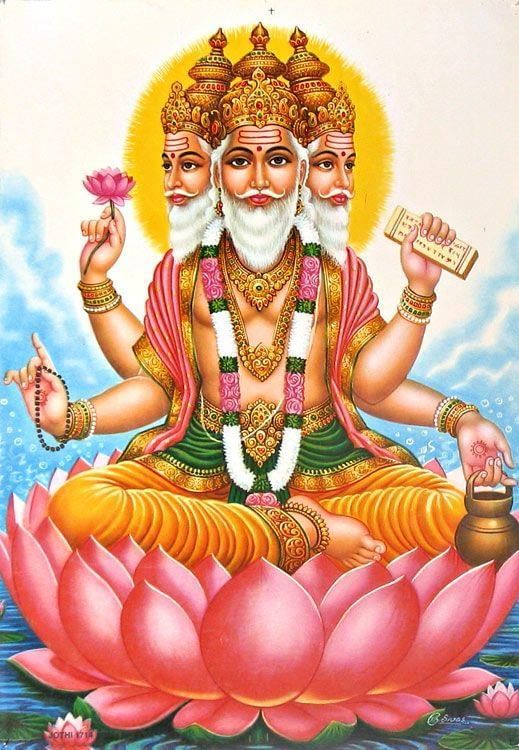
- Iconography:
- Brahma is typically depicted with four faces, each facing one of the four cardinal directions (north, south, east, west), symbolizing his creation of the entire universe.
- He holds four symbolic objects:
- The Vedas: Represent the earliest Hindu scriptures, indicating Brahma’s guidance by them, and some believe he originated them.
- The spoon: A sacrificial ladle used in worship, signifying Brahma’s role in offerings.
- Mala: A string of prayer beads used in meditation.
- The water pot: Symbolizes the water of life, essential for the beginning of creation.
- Worship:
- Brahma is the least worshipped deity in Hinduism today.
- Only two temples in India are dedicated to him, in contrast to thousands devoted to Vishnu and Shiva.
- Reasons for limited worship include:
- A myth where Shiva cursed Brahma for being distracted by worldly desires, decreeing that he should not be worshipped.
- Brahma’s role as creator is considered complete, with Vishnu and Shiva taking on ongoing roles of preservation and transformation.
Vishnu
- Vishnu is the second deity in the Hindu Trimurti, tasked with preserving and protecting the universe.
- He restores balance between good and evil during troubled times.
Quote from Shree Vishnu Mantra: "I pray to the Lord Vishnu. He who holds the universe in his hands. He whose vision exceeds beyond all the skies. He whose colour and visage is changeable like the clouds. He who is filled with goodness in every part of his body."
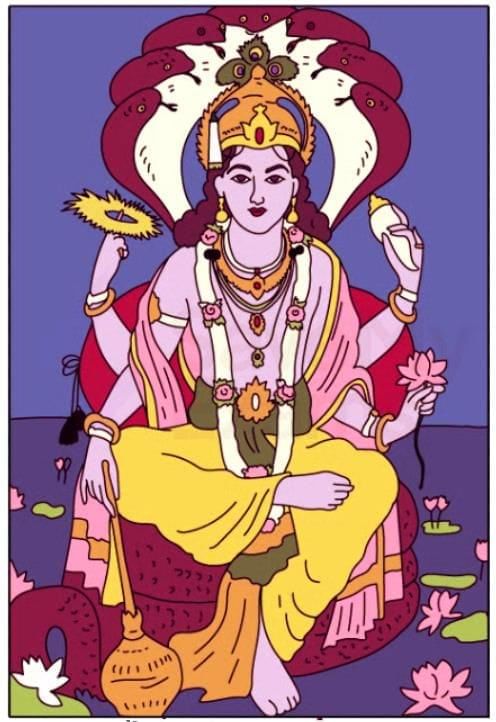
- Iconography:
- Vishnu is often depicted lying on a serpent or with a serpent behind his head, symbolizing cosmic time and energy.
- His blue color represents his infinite spiritual power.
- He has four hands, holding:
- A conch shell: Symbolizes the cosmic sound calling people to live purely.
- A discus (chakra): Represents Vishnu’s divine thoughts, believed to have been used to defeat demons threatening dharma.
- A mace: Symbolizes control over time, often interpreted as knowledge.
- A lotus flower: Represents purity and spiritual enlightenment.
- Avatars:
- Vishnu has incarnated nine times, with a tenth avatar, Kalki, expected near the end of the current world cycle.
- According to the Vishnu Purana, Kalki will appear wielding a sword, riding a white horse, and delivering justice to wrongdoers across the earth.
- Worship:
- Vishnu’s devotees, known as Vaishnavas, consider him the supreme deity, viewing other gods as lesser.
- Vaishnavism is the monotheistic worship of Vishnu alone.
Shiva
- Shiva is the third deity in the Hindu Trimurti, known as both the Destroyer and the Transformer.
- His destruction paves the way for rebirth and change, symbolizing self-awareness and internal understanding.
- Shiva is also the patron god of yogis and yoga.
Quote from Taittiriya Upanishad: "Shiva is the destroyer of the world, but also the creator and the one who restores balance."
- Iconography:
- Shiva is depicted with a third eye on his forehead, symbolizing his ability to see beyond human perception, opening to destroy evil or outdated elements.
- A serpent, Vasuki, is coiled around his neck, reflecting his tranquil nature and fearlessness, as well as mental alertness.
- A crescent moon on his head signifies spiritual wisdom.
- He holds a trident (trishul), with its three spikes representing the three gunas (qualities of nature), indicating Shiva transcends these qualities and the states of waking, dreaming, and sleeping.
- Cultural Role:
- Known as the Lord of Dance, Shiva is worshipped by classical Indian dancers before public performances.
Male & Female Deities
What is a Deity?
- Hindus believe Brahman is the ultimate reality, with deities representing various aspects of Brahman.
- Each deity reveals a facet of Brahman’s nature.
- Hinduism is sometimes mislabeled as polytheistic or idolatrous, but it is monotheistic, as all deities are manifestations of the singular Brahman.
Male Deities
- Male deities reflect different qualities of Brahman, the Ultimate Reality.
Ganesha
- Recognized by his elephant head, Ganesha is one of the most worshipped Hindu deities.
- Son of Shiva and Parvati, he is known as the remover of obstacles.
- Commonly worshipped at weddings to ensure a happy marriage.
- Symbolic Features:
- Big ears: To listen more.
- Small mouth: To speak less.
- Big head: To think big.
- Small eyes: To concentrate more.
- One tusk: To retain good and discard bad.
- Trunk: Symbolizes efficiency and adaptability.
- Large stomach: Represents happiness and prosperity.
- Outward-facing palm: Offers blessings.
- Modaka: A sweet representing the reward of spiritual practice.
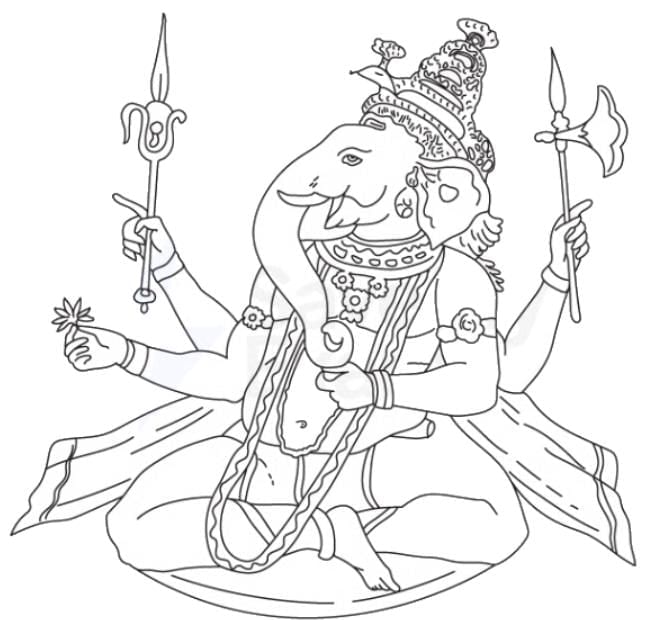
Hanuman
- The monkey god, a key figure in the Ramayana, an epic tale of Prince Rama rescuing his wife Sita from the demon king Ravana.
- Hanuman, half-monkey and half-human, is Rama’s devoted follower, symbolizing selfless service.
- Worshipped for his devotion and ability to overcome difficulties.
- Symbolic Features:
- Monkey face: Represents his role as king of the monkeys.
- Crown: Signifies his divine qualities.
- Mace: Symbolizes strength.
- Magical powers: Includes the ability to fly.
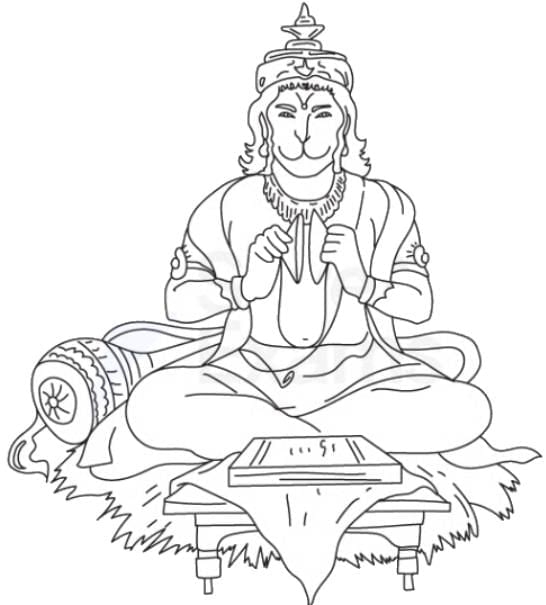
Female Deities
Lakshmi
- Goddess of wealth and beauty, consort of Vishnu.
- Worshipped during festivals like Diwali for prosperity and when seeking new jobs.
- Symbolic Features:
- Her four hands represent the four goals of life: Dharma (duty), Kama (desire), Artha (wealth), and Moksha (liberation).
- Red and gold colors: Symbolize active energy and prosperity.
- Coins: Linked to wealth.
- Lotus seat and flowers: Represent divine truth, fertility, beauty, purity, and spirituality.
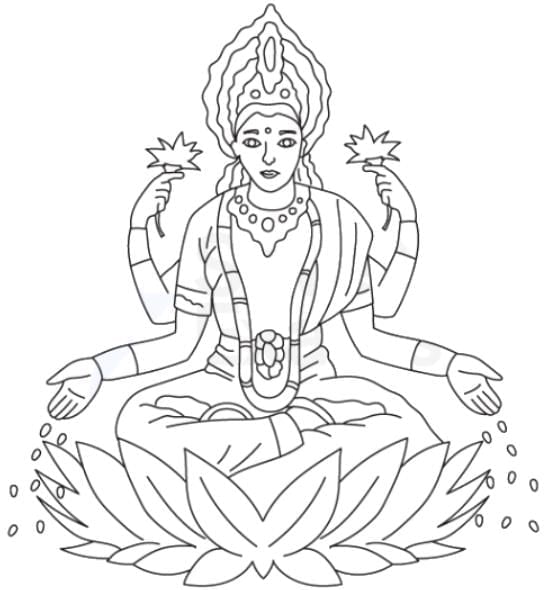
Shakti
- Represents divine feminine energy, depicted with many weapons and riding a tiger.
- Consort of Shiva and mother of Ganesha (with Shiva).
- Manifests in forms such as:
- Parvati: Shiva’s first wife, depicted as a beautiful mother goddess with golden skin, embodying compassion, love, and strength.
- Durga: A warrior goddess with multiple weapons, symbolizing energy.
- Kali: Associated with death and demons, representing both power and creative energy.
- Celebrated during the Navratri festival, a nine-night event involving fasting, puja, and rituals to honor Durga’s forms.
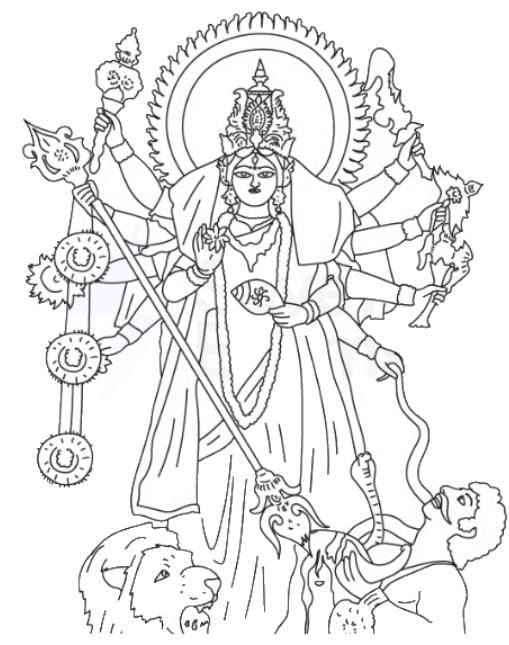
Saraswati
- Goddess of learning, consort of Brahma, and mother of Manu (associated with the Laws of Manu, moral scriptures).
- Worshipped by students and musicians.
- Symbolic Features:
- Swan mount: Symbolizes discernment between good and evil, eternal and temporary.
- Halo: Represents an aura of knowledge.
- Veena (musical instrument): Symbolizes tuning the mind and heart.
- Book: Represents knowledge and wisdom.
- Rosary: Signifies concentration and meditation.
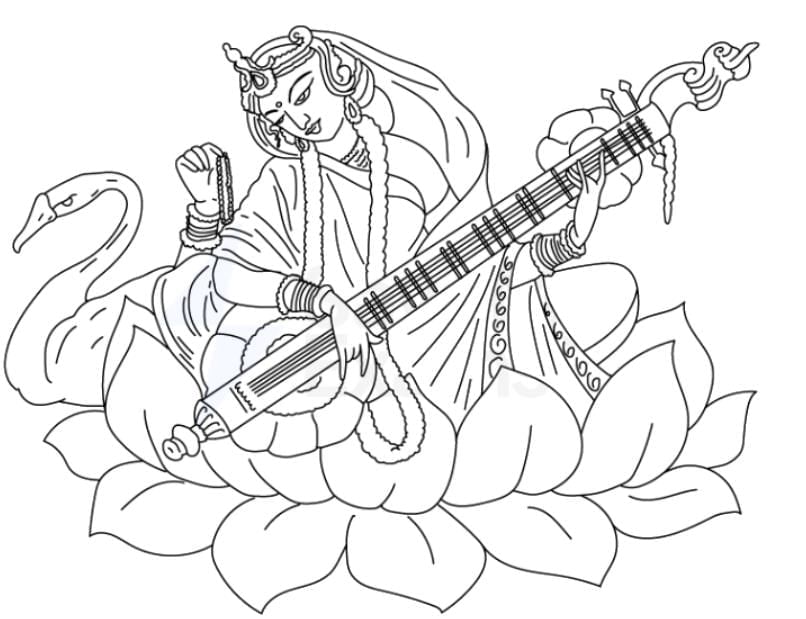
What is the Concept of Avatara?
- An avatar is an incarnation of a god appearing on earth in a living form.
- Gods descend as avatars when goodness declines, and evil influences human actions.
- Example: Vishnu’s seventh avatar, Lord Rama, fought the demon Ravana to restore dharma.
Avatars of Vishnu
- Vishnu, the preserver, appears in various forms to sustain life.
- He has 10 avatars, with the most significant being:
- 7th: Lord Rama – The Perfect Man.
- 8th: Lord Krishna – The Divine Statesman.
- The 10th avatar, Kalki, is yet to appear, expected to ride a white horse and wield a sword to eradicate evil at the end of the current world cycle.
- List of Vishnu’s 10 Avatars:
- Matsya – The Fish
- Kurma – The Tortoise
- Varaha – The Boar
- Narasimha – The Man-Lion
- Vamana – The Dwarf
- Parasurama – The Angry Man
- Lord Rama – The Perfect Man
- Lord Krishna – The Divine Statesman
- Balarama – Krishna’s Elder Brother
- Kalki – The Mighty Warrior (yet to come)
Shakti as an Avatar of Parvati
- Shakti is the divine feminine force, recognized as the consort of Shiva and the embodiment of creative energy, motherhood, and fertility.
- She is depicted with eight arms, seven holding weapons and one open to signify “fear not,” riding a tiger to symbolize her power.
- Shakti manifests in forms like Parvati, Durga, and Kali, seen by her devotees as aspects of her creative energy.
- The three main female deities—Saraswati, Lakshmi, and Shakti—are consorts of the Trimurti gods (Brahma, Vishnu, and Shiva, respectively), highlighting their integral roles in Hindu cosmology.
|
172 docs|3 tests
|
FAQs on How Does the Divine Present - Religion, Philosophy & Ethics for GCSE/IGCSE - Year 11
| 1. What is the significance of the Trimurti in Hinduism? |  |
| 2. How do male and female deities interact within Hindu mythology? |  |
| 3. What does the term 'Avatara' mean in Hinduism? |  |
| 4. How does the concept of Avatara relate to the idea of divine intervention in Hinduism? |  |
| 5. What is the relationship between the Trimurti and the concept of Avatara? |  |



















